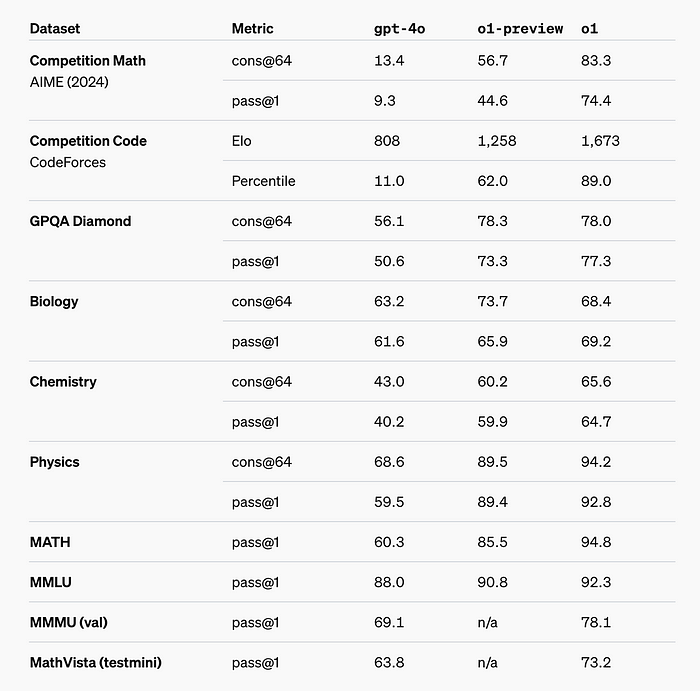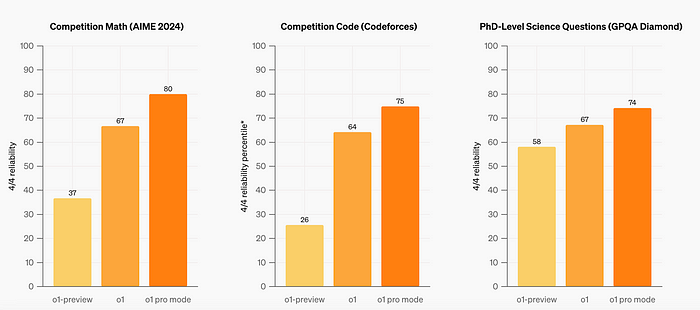Papers Explained 211: o1

OpenAI o1 is a large language model trained with reinforcement learning to perform complex reasoning. o1 thinks before it answers — it can produce a long internal chain of thought before responding to the user.
Through training, the models learn to refine their thinking process, try different strategies, and recognize their mistakes. Reasoning allows o1 models to follow specific guidelines and model policies we’ve set, ensuring they act in line with our safety expectations. This means they are better at providing helpful answers and resisting attempts to bypass safety rules, to avoid producing unsafe or inappropriate content.
The models are pre-trained on diverse datasets, including a mix of publicly available data, proprietary data accessed through partnerships, and custom datasets developed in-house, which collectively contribute to the models’ robust reasoning and conversational capabilities.
The large-scale reinforcement learning algorithm teaches the model how to think productively using its chain of thought in a highly data-efficient training process.
It is found that the performance of o1 consistently improves with more reinforcement learning (train-time compute) and with more time spent thinking (test-time compute).
How reasoning works
The o1 models introduce reasoning tokens. The models use these reasoning tokens to “think”, breaking down their understanding of the prompt and considering multiple approaches to generating a response. After generating reasoning tokens, the model produces an answer as visible completion tokens, and discards the reasoning tokens from its context.

Advice on prompting
These models perform best with straightforward prompts. Some prompt engineering techniques, like few-shot prompting or instructing the model to “think step by step,” may not enhance performance and can sometimes hinder it.
- Keep prompts simple and direct: The models excel at understanding and responding to brief, clear instructions without the need for extensive guidance.
- Avoid chain-of-thought prompts: Since these models perform reasoning internally, prompting them to “think step by step” or “explain your reasoning” is unnecessary.
- Use delimiters for clarity: Use delimiters like triple quotation marks, XML tags, or section titles to clearly indicate distinct parts of the input, helping the model interpret different sections appropriately.
- Limit additional context in retrieval-augmented generation (RAG): When providing additional context or documents, include only the most relevant information to prevent the model from overcomplicating its response.
Evaluation
o1 significantly outperforms GPT-4o on the vast majority of these reasoning-heavy tasks.
- o1 greatly improves over GPT-4o on challenging reasoning benchmarks. Solid bars show pass@1 accuracy and the shaded region shows the performance of majority vote (consensus) with 64 samples.
- o1 improves over GPT-4o on a wide range of benchmarks, including 54/57 MMLU subcategories.
A model is trained by initializing from o1 and training to further improve programming skills. This model competed in the 2024 International Olympiad in Informatics under the same conditions as the human contestants.
It scored 213 points and ranked in the 49th percentile in the 2024 IOI.

o1 ranks in the 89th percentile on competitive programming questions (Codeforces), places among the top 500 students in the US in a qualifier for the USA Math Olympiad (AIME), and exceeds human PhD-level accuracy on a benchmark of physics, biology, and chemistry problems (GPQA).
o1 preview
o1-preview is an early model, it doesn’t yet have many of the features that make ChatGPT useful, like browsing the web for information and uploading files and images.
o1-mini
OpenAI o1-mini is a cost-efficient reasoning model, excelling at STEM, especially math and coding — nearly matching the performance of OpenAI o1 on evaluation benchmarks
Evaluation

Mathematics: In the high school AIME math competition, o1-mini (70.0%) is competitive with o1 (74.4%)–while being significantly cheaper–and outperforms o1-preview (44.6%). o1-mini’s score (about 11/15 questions) places it in approximately the top 500 US high-school students.

Coding: On the Codeforces competition website, o1-mini achieves 1650 Elo, which is again competitive with o1 (1673) and higher than o1-preview (1258). This Elo score puts the model at approximately the 86th percentile of programmers who compete on the Codeforces platform. o1-mini also performs well on the HumanEval coding benchmark and high-school level cybersecurity capture the flag challenges (CTFs).

STEM: On some academic benchmarks requiring reasoning, such as GPQA (science) and MATH-500, o1-mini outperforms GPT-4o. o1-mini does not perform as well as GPT-4o on tasks such as MMLU and lags behind o1-preview on GPQA due to its lack of broad world knowledge.

Model Speed: While GPT-4o did not answer correctly, both o1-mini and o1-preview did, and o1-mini reached the answer around 3–5x faster.
o1 pro mode
o1 pro mode produces more reliably accurate and comprehensive responses, especially in areas like data science, programming, and case law analysis.
Compared to both o1 and o1-preview, o1 pro mode performs better on challenging ML benchmarks across math, science, and coding.


O3 Mini
OpenAI o3-mini is the latest, most cost-efficient reasoning model from OpenAI, focusing on STEM capabilities (science, math, and coding). It is trained with reinforcement learning for complex reasoning, employing a “think before you answer” approach. The model is pre-trained on diverse datasets (public and custom) with rigorous filtering for quality and safety. o3-mini supports function calling, structured outputs, and developer messages, making it production-ready. It offers three reasoning effort options (low, medium, and high) for optimizing speed vs. accuracy. Unlike OpenAI o1, o3-mini does not support visual reasoning tasks.
- o3-mini with medium reasoning effort matches o1’s performance in math, coding, and science, including some of the most challenging reasoning and intelligence evaluations like AIME and GPQA, while delivering faster responses.
- Evaluations by expert testers showed that o3-mini produces more accurate and clearer answers, with stronger reasoning abilities, than OpenAI o1-mini. Testers preferred o3-mini’s responses to o1-mini 56% of the time and observed a 39% reduction in major errors on difficult real-world questions.
Competition Math (AIME 2024)
The gray shaded regions show the performance of majority vote (consensus) with 64 samples.
- With low reasoning effort, OpenAI o3-mini achieves comparable performance with OpenAI o1-mini.
- With medium effort, o3-mini achieves comparable performance with o1.
- With high reasoning effort, o3-mini outperforms both OpenAI o1-mini and OpenAI o1.
PhD-level Science Questions (GPQA Diamond)
- With low reasoning effort, OpenAI o3-mini achieves performance above OpenAI o1-mini.
- With high effort, o3-mini achieves comparable performance with o1.
FrontierMath
- OpenAI o3-mini with high reasoning performs better than its predecessor on FrontierMath.
- When prompted to use a Python tool, o3-mini with high reasoning effort solves over 32% of problems on the first attempt, including more than 28% of the challenging (T3) problems.
Competition Code (Codeforces)
- o3-mini achieves progressively higher Elo scores with increased reasoning effort, all outperforming o1-mini. With medium reasoning effort, it matches o1’s performance.
Software Engineering (SWE-bench Verified)
- o3-mini is the highest performing released model on SWEbench-verified.
LiveBench Coding
- OpenAI o3-mini surpasses o1 even at medium reasoning effort.
- At high reasoning effort, o3-mini further extends its lead, achieving significantly stronger performance across key metrics.
General knowledge
- o3-mini outperforms o1-mini in knowledge evaluations across general knowledge domains.
Paper
Hungry for more insights?
Don’t miss out on exploring other fascinating threads in this series. Simply click here and uncover the state-of-the-art research!
Do Subscribe for weekly updates!!
